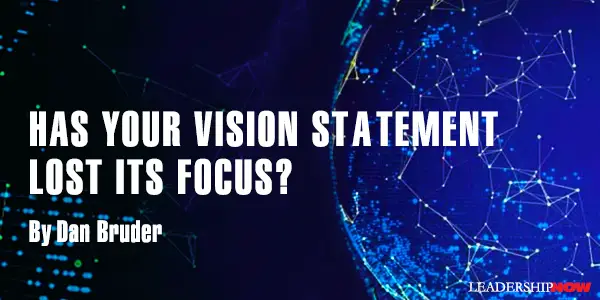 |
 |
09.11.20

Has Your Vision Statement Lost Its Focus?
COMPANY vision statements have been a key tool for leaders over the past several decades, but the traditional vison statement does not connect with the wave of new workers. Further, when asked, many senior leaders struggle to remember their organization’s vision. I started observing how vision statements were losing focus several years ago. I was touring a large manufacturing company and, as I walked through the office, there was a gigantic display of their vision statement on the wall. I complemented the CEO on the impressive presentation of their vision statement. He laughed and said, “No one in the company, including me, really knows our vision statement. The truth is, it was a good way to fill up the space on the wall when we moved into our facility.” Later, I was teaching a capstone MBA class and the topic was evaluating company vision statements. After going through the standard overview, I asked the students what their thoughts were on organization vision statements. For the next five minutes, we talked about the textbook definition. I then asked what they really thought about the term “vision.” Still, more textbook answers, until one student brilliantly said, “I think it’s a bunch of crap!” He elaborated (and I paraphrase), calling it just corporate jargon so senior management can tell people a bunch of feel-good stuff that they don’t believe. Finally, I thought to myself, the answer I was looking for—and you won’t find that in the textbook. For decades, there has been discussion about the importance of having a vision statement. As a result, many organizations have gone through the exercise of creating a vision and then having it printed and handed out to employees. Some have even gone so far as to copy and paste it to their email signature. The process typically ends with a vision statement that has no connection to the employees, customers, or community. Thus, the vision becomes a lost statement that does little to move the organization forward. Why have vision statements fallen out of focus? The key reason: they typically do not connect to what drives and motivates employees. Today’s younger workforce does not trust the traditional vision statement where focus is placed on industry or world dominance. Traditional vision statements do not energize or align today’s workers. While competitive dominance and service excellence are nice goals for senior managers, they do not motivate frontline employees. At their core, people get motivated for a cause. A cause gets them out of bed in the morning. A cause keeps them thinking about their contribution even when they are hiking, sitting on the beach, biking, or skiing. A cause brings people together. It is the foundation for extra effort to identify breakthrough solutions. From an organizational perspective, a cause is how I see the world as a result of my company’s behaviors, actions, and habits. A cause solves a meaningful problem. It’s inspirational, motivational, and energizing; it connects with our emotions. Traditional vision statements do not have that type of impact. A group of unified people aligned with a common cause has the power to change the world and lead your organization to its highest potential. A cause makes a bold statement. Consider what Wikipedia aims to create, or its cause: A world where every single person is given free access to the sum of all human knowledge. Teach For America’s cause is equally compelling: All children in this nation will have the opportunity to attain an excellent education. An effective Statement of Cause isn’t restricted to large organizations. Here are a couple of examples from smaller companies:
These are the types of statements that motivate, align, and energize people. A Statement of Cause helps organizations attract and select new hires and evaluate existing employees. It provides the fuel for meetings and the motivation to remain focused. If done right, a Statement of Cause sets the foundation for culture that aligns strategy and influences operational execution. When vision is simply a tagline at the bottom of an email or a sign on the wall, it cannot possibly be the driving force for activating personal and organizational potential. True leaders understand that having a cohesive cause becomes the focal point of the organization, inspiring employees and building a culture that delivers on the brand promise. Great leaders know that a Statement of Cause is the foundational catalyst that enlivens an organization and engages customers, ultimately enhancing employees’ lives, their communities, and all others touched by the organization. Forget meaningless vision. It is time to replace the traditional, old school vision statement with a Statement of Cause.  
Posted by Michael McKinney at 08:14 AM
|
BUILD YOUR KNOWLEDGE
 

How to Do Your Start-Up Right STRAIGHT TALK FOR START-UPS 
Grow Your Leadership Skills NEW AND UPCOMING LEADERSHIP BOOKS 
Leadership Minute BITE-SIZE CONCEPTS YOU CAN CHEW ON 
Classic Leadership Books BOOKS TO READ BEFORE YOU LEAD |